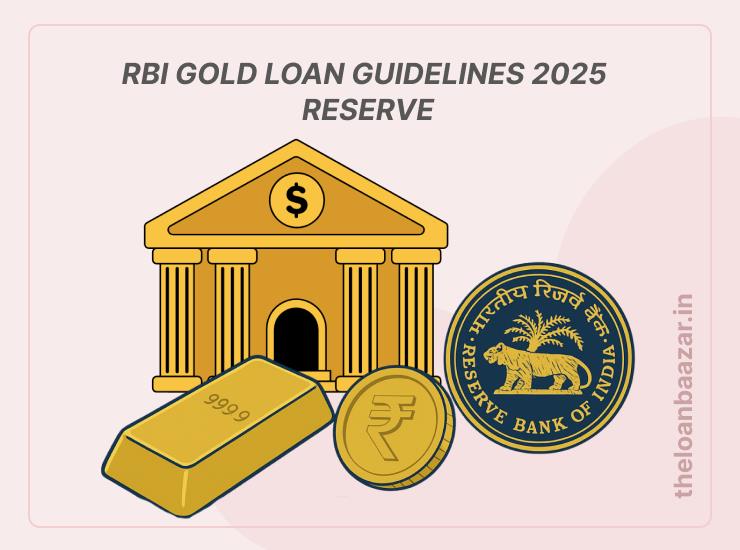The Reserve Bank of India (RBI) has rolled out new regulations for gold-backed loans in 2025, introducing stricter compliance and borrower-friendly measures. These guidelines are designed to make the lending process more transparent, safeguard borrower interests, and reduce risks for banks and NBFCs.
Gold loans have long been a reliable financing option for millions of households across India. However, issues such as unfair auction practices, opaque collateral handling, and risky repayment models have raised concerns. With the latest update, the RBI has taken a significant step to strengthen trust in this sector.
Key Changes in RBI’s Gold Loan Guidelines 2025
One of the most notable reforms is the introduction of tiered loan-to-value (LTV) ratios. Unlike earlier when a flat LTV ratio was applied, borrowers will now fall under different slabs depending on their repayment period and credit profile. Customers with a stable repayment history or shorter tenures may qualify for higher LTVs, while riskier profiles will have to settle for lower borrowing limits. This move ensures responsible lending and discourages excessive leverage.
The RBI has also tightened norms around repayment structures. While the popular bullet repayment option—where the entire principal is cleared at the end of tenure—is still allowed, it now comes with restrictions. The regulator is encouraging EMI-based repayment systems, which distribute the burden evenly and help reduce the chances of default.
Another major update is related to gold auctions. Lenders must now follow transparent procedures with clear timelines for borrower notification, proper valuation, and fair disposal of pledged assets. Auctions may also require third-party oversight to ensure borrowers are not unfairly impacted by undervaluation.
Additionally, the RBI has mandated that lenders return collateral within a fixed time frame after full repayment. Any delay in handing back pledged gold can invite penalties. This rule is aimed at boosting borrower confidence and eliminating malpractices around asset retention.
Finally, the RBI is pushing for greater transparency and reporting. Banks and NBFCs are required to disclose all charges, repayment options, and auction norms upfront. Periodic reporting of gold loan portfolios to the RBI is also mandatory, ensuring closer monitoring of this fast-growing lending segment.
Why These Guidelines Are Important
Gold loans contribute significantly to India’s lending ecosystem, with disbursements exceeding ₹2.5 lakh crore annually. They play a critical role, especially in rural and semi-urban areas, where access to formal credit can be limited.
The new guidelines are expected to:
-
Protect borrowers from hidden charges and unfair auction practices.
-
Ensure fair valuations of pledged gold.
-
Reduce systemic risks for banks and NBFCs.
-
Strengthen trust in gold-backed lending.
Impact on Borrowers
Borrowers may experience lower borrowing power due to tiered LTVs, particularly if they have weaker credit profiles. At the same time, the focus on EMI-based repayment means they will no longer be overly reliant on bullet repayment options.
The new auction rules give borrowers more security, ensuring pledged gold is valued fairly before being sold. Most importantly, borrowers can now expect faster release of their gold once the loan is cleared, eliminating unnecessary delays.
Impact on Lenders
For lenders, the new framework means greater compliance responsibilities. Banks and NBFCs will need to upgrade systems to track repayment schedules, ensure timely auctions, and handle collateral return efficiently. While operational costs may increase slightly, the sector is expected to benefit from lower default rates and higher borrower trust.
In the long run, these reforms will make lenders more competitive and borrower-friendly, strengthening the overall gold loan ecosystem.
FAQs on RBI Gold Loan Guidelines 2025
Q1. What is the revised LTV ratio in 2025?
The RBI has shifted to a tiered LTV system, where safer loans with shorter terms may enjoy higher borrowing limits, while riskier loans face lower ratios.
Q2. Are bullet repayment schemes still allowed?
Yes, but with stricter controls. The RBI is pushing for EMI-based repayment as the standard to reduce borrower stress and defaults.
Q3. How have gold auction rules changed?
Auctions must now follow transparent procedures, including borrower notification, fair valuation, and strict timelines. This prevents undervaluation and ensures fair practices.
Q4. When must lenders return pledged gold?
The RBI requires lenders to return gold within a defined period after full repayment. Any delay can attract penalties.
Q5. Do these rules apply to NBFCs as well?
Yes. Both scheduled banks and registered NBFCs are covered under the 2025 guidelines.
Final Thoughts
The RBI Gold Loan Guidelines 2025 mark a crucial shift in how gold-backed lending will function in India. By tightening norms around LTV ratios, repayment methods, auctions, and collateral return, the regulator is addressing long-standing challenges in the industry.
For borrowers, this means greater protection and fairness, while lenders will benefit from reduced risks and improved transparency. As gold continues to be one of India’s most trusted financial assets, these reforms will help build a more stable and secure lending environment for the future.













